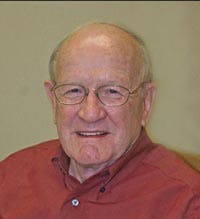Q: How did you get into the GSE/AGE industry?
A: Since the Korean Conflict was on and several of my friends were being drafted, I thought I had better make a selection as to what branch of the service I wanted, so I enlisted in the Air Force with no specific career field in mind. I grew up working in my father’s service stations/garages. I guess I was destined to get into a career field that consisted of mechanical/electrical systems. I was placed into the automotive career field because at that time there was no AGE career field. I went to technical training at Francis E. Warren Air Force Base, Cheyenne, WY. After graduating from technical training I was given a special duty assignment into Security Service Command and sent to Germany, England and Scotland. I was assigned to the automotive maintenance shop where I performed maintenance on all types of engines and mobile and fixed generators that supplied power needed when commercial power was not available. During this time the automotive engine/electrical career fields became one career field known as Power Generation and consequently became the AGE career field. The first AGE shops were co-utilized with the automotive shops. However, as AGE became more sophisticated to support aircraft systems the AGE shops were placed closer to the flight lines to be more accessible to support the aircraft. I spent more than 26 years in the Air Force as an AGE person rising to the ranks of Chief Master Sergeant, the highest enlisted rank attainable. The highlight of my AGE career was when I returned from South East Asia and was assigned to Chanute Air Force Base, IL, where I became the superintendent of the AGE school. The school was located in an old jet engine test cell building and was taught in that facility until 1974. When I returned from South East Asia in 1970 one of my first tasks was to help in the design of a new facility just for AGE training. It was to be the show place with special electrical and exhaust designed to operate AGE inside. The AGE school at Chanute closed in April 1993 due to Base Realignment and Closure (BRAC). The AGE technical training transitioned from Chanute to Sheppard Air Force Base, TX, where it is taught today.
Q: What are you doing in the field currently?
A: After retiring from the Air Force I was hired into civil service at Chanute. I returned to the AGE technical training arena where I was placed into the training evaluation section and evaluated all AGE training both in resident and at operational units in the field. I moved into the position as AGE Training Manager where I coordinated with all commands and the Pentagon on all training aspects of AGE. Another highlight of my career as a civilian and being in AGE was my participation in the Aircraft Ground Support Equipment Working Group (AGSEWG). This consists of all AGE Functional Managers assigned to all commands. Through the AGSEWG the school receives the latest state-of-the-art equipment to be taught. Another accomplishment I achieved as AGE Training Manager was being instrumental in increasing the academic training days from 81 to 106 academic days. Course equipment was updated to mirror what is being used in the field. Course teaching methodology was changed and curriculum rewritten. As a result the new graduates reporting to their first duty assignment were “mission-ready airmen.” Additionally, I was instrumental in the development and teaching of the new 7-level craftsman training. Two unique courses were developed. One is tailored to train Air National Guard and Air Force Reserve Command craftsman personnel and the other specifically for the active duty personnel. I’m now Chief of Training Support Flight and the 361st Training Squadron responsible for training in aerospace propulsion (jet engines/ turboprop), AGE, aircraft fuels systems, aircrew life support, survival equipment, aircrew egress systems, aircraft metals technology, aircraft structural maintenance, nondestructive inspection and vehicle body maintenance.
Q: What trends have you seen over the years — technology, etc?
A: As the aircraft have become more complex the AGE systems developed along with it. I have operated and maintained equipment where everything was controlled manually. Today most everything is controlled electronically. Originally, troubleshooting equipment was often trial and error. Today you have test ports and data display units that take the guess out of finding problems. With these changes we have changed our teaching methodology. Computers allow technology to be used in teaching and developing our courses. Writing on chalk boards has been replaced by PowerPoint. Graduates from the AGE courses and all other courses are far smarter and ready to perform in the operational units with less on-the-job training.
Q: Any advice to others in the field?
A: For those in the AGE career field, you are in the best career in the Air Force. No other career field that I’m familiar with has as many different systems that an AGE person has to work on. Students must understand the theory and principles of operation with air conditioning, hydraulic test stands, air compressors, heaters, gasoline, diesel and gas turbine generators, electronic frequency converters and motor generators. My advice is to be positive and never say I can’t do that. Get involved, volunteer for jobs others are reluctant to do. AGE is a never ending learning experience. Keep an open mind and learn something new everyday. Share and communicate with your coworkers.
Q: Anything else you feel is important for our readers to know?
A: Yes. There is nothing an AGE person can’t do. AGE is the most versatile career field there is. For those retiring or leaving after their tour is up you are blessed with a skill for which any employer is waiting with open arms.





